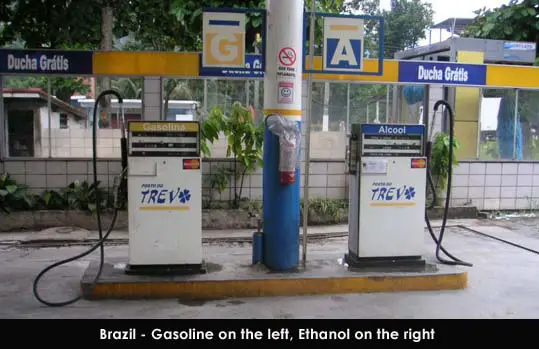The largest national use of ethanol biofuel exists in Brazil (gasoline sold in Brazil contains at least 20% ethanol and hydrous ethanol is also used as fuel). In order for ethanol (ethyl alcohol) to be suitable for use as a replacement to petrol in its pure form, it must be distilled to at least 70-80% purity by volume before use. For use as an additive to petrol, almost all water must be removed; otherwise it will separate from the mixture and settle to the bottom of the fuel tank, causing the fuel pump to draw water into the engine, which will cause the engine to stall.

Ethanol Biofuel
Today almost 50% of Brazilian cars are able to use 100% ethanol biofuel, that includes ethanol only engines and flex fuel engines. Flex fuel engines are able to work with all ethanol, all gasoline or any mixture of both, giving the buyer a choice between price and performance. That was only possible due to the capability of an efficient sugar cane production. Sugar cane not only has a greater concentration of sucrose (about 30% more than corn) but is also much easier to extract. The bagasse generated by the process is not wasted and it is utilized in power plants. World production of ethanol in 2006 was 51 billion litres, (13.5 billion gallons), with 69% of the world supply coming from Brazil and the United States.
Currently the main feedstock in the United States for the production of ethanol biofuel is corn. Approximately 2.8 gallons (10 litres) of ethanol are produced from one bushel of corn (35 litres). While much of the corn turns into ethanol, some of the corn also yields by products such as DDGS (distillers dried grains with solubles) which can be used to fulfill a portion of the diet of livestock. A bushel of corn produces about 18 pounds of DDGS.
Corn is an energy intensive crop that requires petroleum derived fertilizers; however, using corn to produce alcohol could save farmers additional petroleum if the farmers are feeding the byproduct to livestock and if the excrement from the animals is then used as fertilizer for the corn. Although most of the fermentation plants have been built in corn-producing regions, sorghum is also an important feedstock for ethanol production in the Plains states. Pearl millet is showing promise as an ethanol feedstock for the southeastern U.S.
Net Energy (energy produced less the amount of energy used to produce it)
There appears to be considerable dispute about the net energy benefit of producing ethanol from food crops including corn, although sugarcane is considered more efficient than most. David Pimentel, a professor of ecology and agriculture at Cornell University, and Tad W. Patzek, professor of civil and environmental engineering at Berkeley both think that ethanol biofuel is not a sustainable strategy. Their findings suggested In terms of energy output compared with energy input for ethanol production, corn requires 29 percent more fossil energy than the fuel produced; switch grass requires 45 percent more fossil energy than the fuel produced; and wood biomass requires 57 percent more fossil energy than the fuel produced.
In contrast, a recent study by Argonne National Laboratory conducted by Michael Wang claims that ethanol generates 35% more energy than it takes to produce. This finding goes against other studies that suggest ethanol production uses more energy than it creates. Conflicting studies may be the result of some regions in the world possessing better growing conditions and more efficient processing systems.
Dr Robert Niven, from the school of aerospace, civil and mechanical engineering at the Australian Defence Force Academy says that E10 increases both the risk and severity of soil and groundwater contamination. In particular increasing benzene contamination, this can remain in place for decades. Dr Niven believes this alone should rule out the use of E10 as a fuel except where groundwater impacts are not of concern.
The Australian Government in the report, Biofuels in Australia – an overview of issues and prospects (June 2007) warns that there are increased evaporative emissions of smog-forming organic compounds which may have a negative impact on air quality and lead to worse health outcomes in some circumstances. What does not appear to be factored into ethanol biofuel are the environmental effects of large scale farming for fuel purposes, which also need to be taken into account.
There seems to be a range of studies suggesting that the net energy yield from corn based ethanol ranges from very substantially negative, to modestly positive. If we are going to shift wholesale to ethanol biofuel we do need to be sure that it not only has a positive net energy yield, but that it is sustainable in the long term.
Other Uses of Ethanol
Ethanol is present in alcoholic drinks (beer, wine, spirits) when diluted. It is used as a topical agent to prevent skin infections, in pharmaceutical preparations (e.g. rubbing compounds, lotions, tonics, colognes), cosmetics, and in perfumes. Ethanol may be present in fuels, labelled as ethanol-blended fuels, and is used as an industrial solvent for fats, oils, waxes, resins, and hydrocarbons. It is used to make many chemical compounds, lacquers, plastics and plasticizers, rubber and rubber accelerators, aerosols, mouthwash products, soaps and cleaning preparations, polishes, surface coatings, dyes, inks, adhesives, preservatives, pesticides, explosives, petrol additives/substitutes, elastomers, antifreeze, yeast growth medium, human and veterinary medicines and as a dehydrating agent.
|
Biomass Technologies
Landfill Gas What is Biofuel? Palm Oil Biodiesel Biodiesel from Algae Biodiesel from Tallow Biofuel Ethics Wood Gas Generator
|
